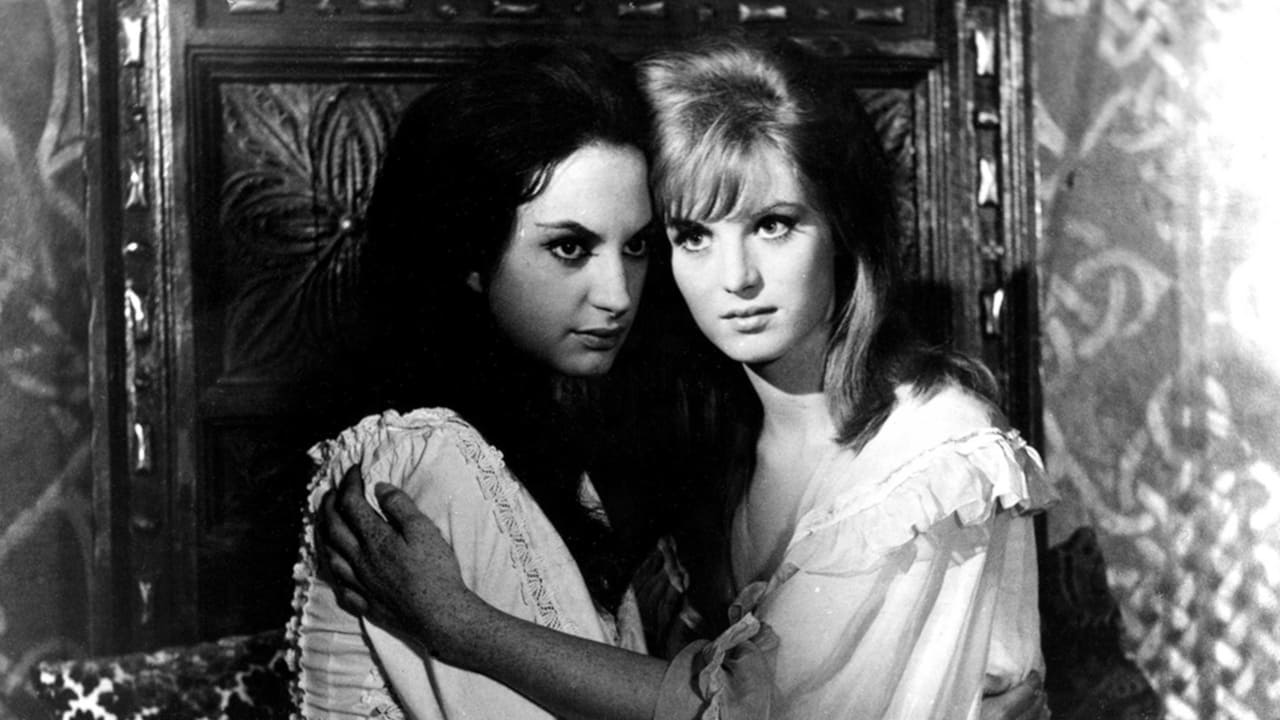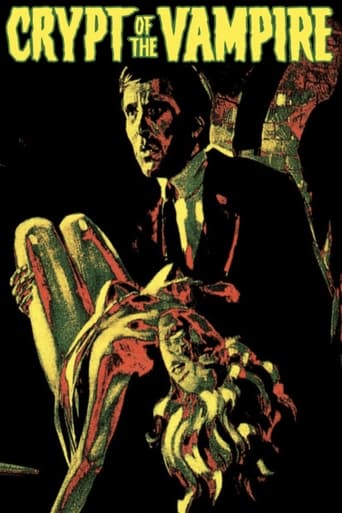

Everyone knows how wonderful the great Christopher Lee can be at playing the monstous heavy--not for nothing is he known to his fans as Mr. Tall, Dark and Gruesome!--but many forget that he can be equally adept at portraying "the good guy." Thus, fans are often pleasantly taken aback when they see the 1968 Hammer film "The Devil Rides Out" for the first time, in which Lee plays the Duc de Richleau, a combater of Satanists in 1920s England (though this film is weak tea compared to Dennis Wheatley's 1934 source novel). For further proof of Lee's ability to portray a defender of right and light, viewers may be interested to seek out Camillo Mastrocinque's Italian Gothic horror film "Crypt of the Vampire" (1964), which can also be seen under the title "Terror in the Crypt" (a superior appellation, I feel, as the vampiric elements in the film are very minor). In this picture, Lee plays the Count Ludwig Karnstein, who fears that his daughter, Laura (Adriana Ambesi), has become possessed by a witch who was put to death by his ancestors 200 years previously, and who had sworn to return to take vengeance on the family's descendants. Following the advice of his young blonde mistress, Annette (Vera Valmont), the count hires a young expert on antiquarian matters, Friedrich Klauss (Jose Campos), to learn more about this deceased witch and, hopefully, unearth a portrait of her. Laura has been suffering strange visions of late, and having eerie dreams, and it really does seem as if the poor gal has become possessed. Her lot brightens, however, when a carriage breaks down near the Karnstein castle, and the beautiful Ljuba (Ursula Davis) becomes a guest in the ancient pile for a few days....If this story line sounds at all familiar, it can be revealed here that, yes, this IS yet another reworking of the oft-filmed Sheridan Le Fanu novelette of 1872, "Carmilla"; I might also add that it is not nearly as effective a filmization as Spanish director Vicente Aranda's "The Blood- Spattered Bride" (1969), a film that I just love. Still, "Crypt of the Vampire" is darn good enough, although its debt to Mario Bava's seminal "Black Sunday," made four years earlier, is fairly apparent, and never more so than in that 17th century witch-slaying sequence. "Crypt" also shares similarities with another Italian Gothic that I had recently watched, 1963's "The Blancheville Monster." Both were filmed in B&W, feature ancient family curses, showcase some impressively moldering, realistically UNDERadorned castles and decrepit tombs, highlight some surrealistic dreams suffered by the leading lady, sport a trio of young starlets, and surprise the viewer with twist endings. And both, unfortunately, suffer from a sluggish middle third and an ending that can only be described as weak; "Crypt" drags even further when Lee is not on the screen. But when he IS present, the picture is galvanized; thank goodness for his always welcome presence, and that great, mellifluous voice of his, which has survived the dubbing process here. Lee's star power gives this film, automatically, an extra, uh, star. I must also add that some scenes in the film do not make 100% sense when considered in the light of that twist ending, and that the characters of Klauss and Laura seem miscast. Jose Campos, a young Bill Bixby type, seems a bit too boyish for the role; someone on the hunky order of Giacomo Rossi Stuart would have been preferable (check him out in Bava's great film from 1966, "Kill, Baby, Kill," to see what I mean). And Adriana Ambesi-- you'll forgive me for saying so--is almost too homely to portray Laura; she looks like a cross between Barbra Streisand's plain Jane sister and the social misfit, Catherine Sloper, that Olivia de Havilland brilliantly portrayed in 1949's "The Heiress." Surely, Italian cinema has never lacked for lovely starlets; any of them might have been preferable.Anyway, the good news is that "Crypt" does boast a number of very well-done scenes, including the discovery of a hanged hunchback with his hand cut off, and the subsequent use of that hand as a candelabra in a Satanic ceremony, as well as the final sequence, in which Count Karnstein & Co. explore the ancient witch's tomb. The film is never without interest, even during its slower stretches, and I suppose is required viewing for all fans of Christopher Lee or Italian Gothic horror. The DVD that it comes to us on, from RetroMedia, sports a decent-looking print but is completely devoid of extras; not even the customary chapter stops! Note to some aspiring outfit: Howzabout a loving restoration and presentation of THIS relatively obscure instance of 1960s Eurohorror?!?!
... View MoreA Christopher Lee flick I'd never even heard of, much less seen. The cult film legend is not the titular bloodsucker in this Spanish-Italian co-production, however. Here the vampire's identity is supposed to be something of a mystery, although if you're at all familiar with Sheridan Le Fanu's "Carmilla", from which the script was adapted, you'll have everything figured out long before the characters do.Director Camillo Mastrocinque piles on the classical Gothic themes and motifs like there's no tomorrow: vampirism, witchcraft, ancient family curses, heaving bosoms straining against diaphanous pregnoirs, creepy castle corridors and crypts by candlelight — that sort of thing. Facilitating this omnipresent atmosphere is some excellent black-and-white cinematography expressly modeled in the style of visual maestro Mario Bava (BLACK Sunday). Adriana Ambesi (FANGS OF THE LIVIND DEAD) and Ursula Davis (SPARTACUS AND THE TEN GLADIATORS) provide the eye candy; the story's lesbian angle is handled quite demurely but is unmistakably present, not merely hinted at yet always kept implicit. While the absence of shocks and skin, not to mention the leisurely pace, may well dissuade the casual fright film viewer the Gothic horror fan will be in his or her element. And you can never go wrong casting Lee as the aloof, aristocratic type.Makes for an interesting double feature with Hammer's THE VAMPIRE LOVERS (1970), which is also inspired by "Carmilla".
... View MoreThough only superficially faithful to Joseph Sheridan Le Fanu's famous novella, "Carmilla," this picture merits praise for its consistent visual distinction, and a unity of mood, (elsewhere, and accurately described as "stately") that lift it far above the overpraised (and dramatically disjointed) "Castle of the Living Dead" which Mr. Lee completed about the same time.Allegedly set in Styria, but filmed in Italy, this film boasts deep focus black and white cinematography that clearly takes its visual cues from Bava's "Black Sunday." Indeed, this film even features a witch condemnation sequence rather similar to the one depicted in the earlier film.The castle interiors are alive with looming shadows, the rooms dressed with the appropriate paraphernalia of the genre, (flaming braziers, suits of armor, baroque prickets and saint statues; while the exteriors contain some of the most enchanting landscapes one could wish for--not to mention unforgettable nightscapes--as of two women fleeing across a hillside in billowing peignoirs and lit by the moon, (rather like the cover of a Phyllis Whitney novel).Also in its favor are some scenes quite faithful to Mr. Le Fanu's original, as in the barouche accident which occasions the arrival of the vampiress, (here re-named "Luba" for inexplicable reasons).There are some demerits: a heroine that looks like a cross between Barbara Streisand and Maria Callas, and an Elke Sommerish Lady in Waiting whose adulterous relationship with Mr. Lee seems entirely gratuitous.Nonetheless, admirers of 1960s Italian gothics need to re-examine this piece which is often unfairly dismissed, as it warrants far more attention and respect than such slush as "Terror Creatures From the Grave."
... View MoreThis is a superbly old-fashioned and atmospheric chiller from the Italian Gothic horror revival of the 60s. The sets and costumes are stately, the camera-work slithery and shadowy (in good old b&w), and the lush score (featuring theremin and other creepy sounds) is a knockout. Since it is based on the Karnstein legend, there are plenty of exotic, full-figured Euro-starlets on hand to heave their breasts and scream, and the lesbian angle is fairly overt. Best of all, it's played with utmost conviction, avoiding the campiness that often crept into these items (intentionally or not). Although there's not enough sex or violence to appeal to modern genre fans, there are a couple of fine shocks and an inescapable atmosphere of doom and ferocity mingled with eroticism. A must-see for the discerning fan, along with the similarly-themed Slaughter of the Vampires.
... View More